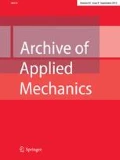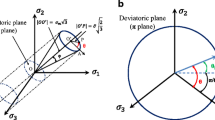Abstract
The damage of materials is the progressive or unexpected deterioration of mechanical strength because of loadings, thermal or chemical effects. The micromechanical damage process of ductile materials is generally studied by the continuum damage mechanics (CDM). One of the most well-known damage models is the Lemaitre’s ductile damage criterion. This model only requires one material-dependent parameter to represent damage evolution. In this investigation first, a novel numerical approach is proposed to determine the Lemaitre’s ductile damage parameter. Then, a user-defined material subroutine founded on the Lemaitre’s ductile damage model is developed. Following, numerical results are achieved for a standard round tensile test specimen. Finally, to validate the suggested method, experimental tests are carried out and compared with the numerical results. The comparison reveals a good agreement and excellent correlation between the numerical and practical results. Hence, it is concluded that the offered numerical approach can accurately determine the Lemaitre’s ductile damage parameter as well as the damage behavior of ductile metals.












Similar content being viewed by others
Abbreviations
- \(\mathrm{A}\) :
-
Total cross section area of RVE
- \({\mathrm{A}}_{D}\) :
-
Damaged area of RVE
- \(D\) :
-
Damage variable
- \({D}_{1C}\) :
-
Critical damage parameter in tension
- \({e}_{u}\) :
-
Elongation
- \(E\) :
-
Young’s modulus
- \(\tilde{E }\) :
-
Effective elasticity modulus
- \(f\) :
-
Yield surface function
- \(\mathrm{G}\) :
-
Shear modulus
- \(\mathbf{I}\) :
-
Second-order identity tensor
- \(K\) :
-
Hardening coefficient
- \(\mathrm{K}\) :
-
Bulk modulus
- \(n\) :
-
Hardening power
- \(p\) :
-
Hydrostatic stress
- \(r\) :
-
Lemaitre’s ductile damage parameter
- \(\mathrm{R}\) :
-
Isotropic hardening function
- \(s\) :
-
Lemaitre’s damage power parameter
- \({\varvec{S}}\) :
-
Deviatoric stress tensor
- \(\nu\) :
-
Poisson’s ratio
- \(Y\) :
-
Damage strain energy release rate
- \({\varvec{\varepsilon}}\) :
-
Strain tensor
- \({{\varvec{\varepsilon}}}^{d}\) :
-
Deviatoric strain tensor
- \({{\varvec{\varepsilon}}}^{e}\) :
-
Elastic strain tensor
- \({\varepsilon }^{p}\) :
-
Plastic strain
- \({{\varvec{\varepsilon}}}^{p}\) :
-
Plastic strain tensor
- \({\varepsilon }^{v}\) :
-
Volumetric strain
- \({\varepsilon }_{eq}^{p}\) :
-
Equivalent plastic strain
- \({\varepsilon }_{pd}\) :
-
Threshold plastic strain
- \({\dot{{\varvec{\varepsilon}}}}^{p}\) :
-
Plastic strain rate tensor
- \(\dot{\gamma }\) :
-
Plastic consistency parameter
- \(\eta\) :
-
Stress triaxiality
- \(\rho\) :
-
Density
- \({\varvec{\sigma}}\) :
-
Stress tensor of virgin material
- \(\stackrel{\sim }{{\varvec{\sigma}}}\) :
-
Effective stress tensor
- \({\sigma }_{eq}\) :
-
Von Mises equivalent stress
- \({\sigma }_{f}\) :
-
Fracture stress
- \({\sigma }_{u}\) :
-
Ultimate stress
- \({\sigma }_{y}^{0}\) :
-
Initial yield stress
- \(\psi\) :
-
Potential dissipation function
- \({\psi }_{D}\) :
-
Damage component of potential dissipation function
- \({\psi }_{P}\) :
-
Plastic component of potential dissipation function
References
Lemaitre, J.: A course on damage mechanics. Springer, Cham (2012)
Kachanov, L.M.: On the time to failure under creep conditions. Izv. AN SSSR Otd. Tekhn. Nauk. 8, 26–31 (1958)
Rabotnov, Y.N.: A model of an elastic-plastic medium with delayed yield. J. Appl. Mech. Tech. Phys. 9(3), 265–269 (1968)
McClintock, F.A.: A criterion for ductile fracture by the growth of holes. Int. J. Fract. Mech. (1968). https://doi.org/10.1007/BF00188939
Cockcroft, M.G., Latham, D.J.: Ductility and the workability of metals. J. Inst. Met. 96(1), 33–39 (1968)
Rice, J.R., Tracey, D.M.: On the ductile enlargement of voids in triaxial stress fields. J. Mech. Phys. Solids 17(3), 201–217 (1969)
Gurson, A.L.: Continuum theory of ductile rupture by void nucleation and growth: part I—Yield criteria and flow rules for porous ductile media. J. Eng. Mater. Technol. 99(1), 2–15 (1977)
Wilkins, M. L., Streit, R. D., & Reaugh, J. E. (1980). Cumulative-strain-damage model of ductile fracture: simulation and prediction of engineering fracture tests (No. UCRL-53058). Lawrence Livermore National Lab., CA (USA); Science Applications, Inc., San Leandro, CA (USA)
Tvergaard, V.: On localization in ductile materials containing spherical voids. Int. J. Fract. 18(4), 237–252 (1982)
Tvergaard, V.: Ductile fracture by cavity nucleation between larger voids. J. Mech. Phys. Solids 30(4), 265–286 (1982)
Needleman, A., Tvergaard, V.: An analysis of ductile rupture in notched bars. J. Mech. Phys. Solids 32(6), 461–490 (1984)
Chaboche, J.L.: Anisotropic creep damage in the framework of continuum damage mechanics. Nucl. Eng. Des. 79(3), 309–319 (1984)
Lemaitre, J.: A continuous damage mechanics model for ductile fracture. J. Eng. Mater. Technol. 107(1), 83–89 (1985)
Johnson, G.R., Cook, W.H.: Fracture characteristics of three metals subjected to various strains, strain rates, temperatures and pressures. Eng. Fract. Mech. 21(1), 31–48 (1985)
Benallal, A., Billardon, R., Doghri, I.: An integration algorithm and the corresponding consistent tangent operator for fully coupled elastoplastic and damage equations. Commun. Appl. Numer. Methods 4(6), 731–740 (1988)
Steinmann, P., Miehe, C., Stein, E.: Comparison of different finite deformation inelastic damage models within multiplicative elastoplasticity for ductile materials. Comput. Mech. 13(6), 458–474 (1994)
Doghri, I.: Numerical implementation and analysis of a class of metal plasticity models coupled with ductile damage. Int. J. Numer. Meth. Eng. 38(20), 3403–3431 (1995)
Dhar, S., Sethuraman, R., Dixit, P.M.: A continuum damage mechanics model for void growth and micro crack initiation. Eng. Fract. Mech. 53(6), 917–928 (1996)
De. Souza Neto, E.A., Peric, D.: A computational framework for a class of fully coupled models for elastoplastic damage at finite strains with reference to the linearization aspects. Comput. Methods Appl. Mech. Eng. 130(1–2), 179–193 (1996)
La. Rosa, G., Mirone, G., Risitano, A.: Effect of stress triaxiality corrected plastic flow on ductile damage evolution in the framework of continuum damage mechanics. Eng. Fract. Mech. 68(4), 417–434 (2001)
De. Souza Neto, E.A.: A fast, one-equation integration algorithm for the Lemaitre ductile damage model. Commun. Numer. Methods Eng. 18(8), 541–554 (2002)
Brünig, M.: An anisotropic ductile damage model based on irreversible thermodynamics. Int. J. Plast 19(10), 1679–1713 (2003)
Hooputra, H., Gese, H., Dell, H., Werner, H.: A comprehensive failure model for crashworthiness simulation of aluminium extrusions. Int. J. Crashworthiness 9(5), 449–464 (2004)
Bonora, N., Gentile, D., Pirondi, A., Newaz, G.: Ductile damage evolution under triaxial state of stress: theory and experiments. Int. J. Plast 21(5), 981–1007 (2005)
Bai, Y., Wierzbicki, T.: A new model of metal plasticity and fracture with pressure and lode dependence. Int. J. Plast 24(6), 1071–1096 (2008)
Rezaiee-Pajand, M., Kazemiyan, M.S., Aftabi, S.A.: Static damage identification of 3D and 2D frames. Mech. Based Des. Struct. Mach. 42(1), 70–96 (2014)
Zhai, X., Wang, Y., Sun, Z.: Damage model and damage assessment for single-layer reticulated domes under exterior blast load. Mech. Based Des. Struct. Mach. 47(3), 319–338 (2019)
Mehditabar, A., Rahimi, G.H.: Cyclic elastoplastic responses of thick-walled FG pipe behaves as a power law function considering damage evolution. Mech. Based Des. Struct. Mach. (2020). https://doi.org/10.1080/15397734.2020.1768112
Simo, J.C., Hughes, T.J.R.: Interdisciplinary applied mathematics. In: Bloch, A., Epstein, C.L., Goriely, A., Greengard, L. (eds.) Mechanics and materials, computational inelasticity. Springer-Verlag, New York (1998)
Mashayekhi, M., Ziaei-Rad, S., Parvizian, J., Niklewicz, J., Hadavinia, H.: Ductile crack growth based on damage criterion: experimental and numerical studies. Mech. Mater. 39(7), 623–636 (2007)
Haji Aboutalebi, F., Farzin, M., Poursina, M.: Numerical simulation and experimental validation of a ductile damage model for DIN 1623 St14 steel. Int. J. Adv. Manuf. Technol. 53(1–4), 157–165 (2011)
Haji Aboutalebi, F., Farzin, M., Mashayekhi, M.: Numerical predictions and experimental validations of ductile damage evolution in sheet metal forming processes. Acta Mech. Solida Sin. 25(6), 638–650 (2012)
Haji Aboutalebi, F., Roostaei, M., Safaie, P.: Empirical determination of Lemaitre's ductile damage parameters for thin sheet metals by variations of the elasticity modulus. Steel Res. Int. 83(Special Issue), 1195–1198 (2012)
Cao, T.S., Gachet, J.M., Montmitonnet, P., Bouchard, P.O.: A Lode-dependent enhanced Lemaitre model for ductile fracture prediction at low stress triaxiality. Eng. Fract. Mech. 124, 80–96 (2014)
Papasidero, J., Doquet, V., Mohr, D.: Ductile fracture of aluminum 2024–T351 under proportional and non-proportional multi-axial loading: Bao-Wierzbicki results revisited. Int. J. Solids Struct. 69, 459–474 (2015)
Gerke, S., Zistl, M., Brünig, M.: Experiments and numerical simulation of damage and fracture of the X0-specimen under non-proportional loading paths. Eng. Fract. Mech. 224, 106795 (2020)
Autay, R., Koubaa, S., Wali, M., Dammak, F.: Numerical implementation of coupled anisotropic plasticity-ductile damage in sheet metal forming process. J. Mech. 34(4), 417–430 (2018)
Ghorbel, O., Koubaa, S., Mars, J., Wali, M., Dammak, F.: Non associated-anisotropic plasticity model fully coupled with isotropic ductile damage for sheet metal forming applications. Int. J. Solids Struct. 166, 96–111 (2019)
Ghorbel, O., Mars, J., Koubaa, S., Wali, M., Dammak, F.: Coupled anisotropic plasticity-ductile damage: modeling, experimental verification, and application to sheet metal forming simulation. Int. J. Mech. Sci. 150, 548–560 (2019)
Bringas, J.E.: Handbook of comparative world steel standards. ASTM, United States (2002)
Standard E8/E8M-16a (2016). Standard test methods for tension testing of metallic materials. An American National Standard. AASHTO No.: T68. pp. 8
Author information
Authors and Affiliations
Corresponding author
Ethics declarations
Conflict of interest
On behalf of all authors, the corresponding author states that there is no conflict of interest.
Additional information
Publisher's Note
Springer Nature remains neutral with regard to jurisdictional claims in published maps and institutional affiliations.
Rights and permissions
About this article
Cite this article
Shamshiri, A.R., Haji Aboutalebi, F. & Poursina, M. A new numerical approach for determination of the Lemaitre’s ductile damage parameter in bulk metal forming processes. Arch Appl Mech 91, 4163–4177 (2021). https://doi.org/10.1007/s00419-021-01998-y
Received:
Accepted:
Published:
Issue Date:
DOI: https://doi.org/10.1007/s00419-021-01998-y




